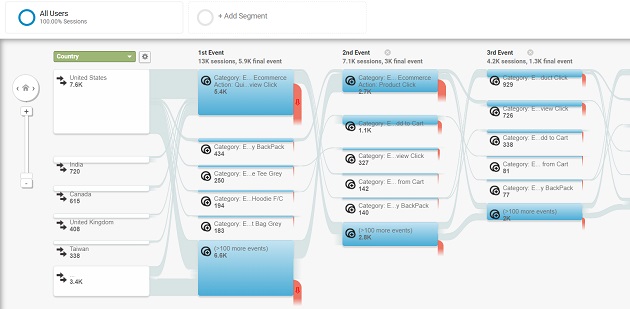Rumored Buzz on Google Analytics Event Tracking
Wiki Article
All about Google Analytics Event Tracking
Table of ContentsSome Known Details About Google Analytics Event Tracking The 45-Second Trick For Google Analytics Event TrackingThe 7-Minute Rule for Google Analytics Event Tracking8 Simple Techniques For Google Analytics Event TrackingSome Known Details About Google Analytics Event Tracking How Google Analytics Event Tracking can Save You Time, Stress, and Money.
If you're going to establish up event tracking manually, after that you're mosting likely to need to add some added code to the elements you intend to gather data from. The code you're going to collaborate with will certainly look something like this: There are 4 components within that code fragment that you're going to require to specify yourself: occasion, Classification, event, Action, occasion, Label and occasion, Worth.
As you can see, 2 of these are required (classification and activity) while label and worth are optional. All of it depends on the type of details you desire communicated back to Google Analytics when a customer clicks on the specified aspect (Google Analytics Event Tracking). It will be a lot easier to define these elements if you analyse your website and decide which elements/actions you desire to track
The Facts About Google Analytics Event Tracking Uncovered
Currently, you'll be asked to define the and and you'll wish to choose from the drop-down food selection that shows up when you click on. This will bring up the same event tracking elements we looked at earlier, which you'll require to submit. Once you have actually specified these, you can relocate down to the 2nd box and choose the trigger that will fire your tag.On the following screen, you'll additionally have an area for calling your trigger and, if you click on the box, you'll see a checklist of the different triggers you can choose. In this case, we intend to choose and after that select the option below. You'll set the trigger to just terminate when a component is clicked with an URL that consists of the.
Every website talks. Before data analytics, we couldn't hear the voices of our internet sites. Exactly how do you understand what your internet site is claiming? Simple - Event tracking! Occasion tracking offers you an image of exactly how individuals engage with your internet site and business (Google Analytics Event Tracking). Do you need to know even more? Then, review on as we discover everything you need to recognize, including what it is, why you ought to track events, how to manage events data, and other relevant Frequently asked questions you may have.
A Biased View of Google Analytics Event Tracking
You can switch in between your event classifications, activities, and labels in the Leading Events report. This report is vital for excavating even more into study on a specific occasion group. The Occasion Pages report displays the web pages where occasions are activated. In this section, we can examine the leading web pages that drive occasions.It shows you the course they take as they move from one occasion to the following and helps you to figure out which content involves your target market the most. Events in Google Analytics have four main elements. They are also a part of the occasion tracking code. Google Analytics utilizes these codes to track customer communications and team them into occasion reports.
A checklist of the specifications you can track on your web site is on the. After examining all needed fields, you can click "X" to close the window and return to the Overview food selection on the.
5 Simple Techniques For Google Analytics Event Tracking

Selecting "False" will certainly protect against that session from being a bounce. If you have not done so, you may require to establish up a variable in the Google Analytics Setups box. Click "New Variable ..." if you can't find one to choose. After this, enter your GA monitoring ID in the Tracking ID field.
Your ID will certainly be on top of the display. To do this, adhere to the next series of actions: After configuring the fields, choose the "Triggering" section. When configuring your new trigger, click the "+" switch, then the "pencil" switch, after that choose your trigger type. Tag your trigger and specify the conditions that result in trigger firing.
Google Analytics Event Tracking Fundamentals Explained

When it comes to knowing which areas and components are assisting consumers through your conversion funnel, you still won't understand. Without event tracking, GA records will only count check outs as single-page sessions, also if users invest a whole lot of time on one page and engage with it significantly (and a bounce).
Exactly how does event tracking accomplish this?Single-page sessions recognized as bounces start and wrap up on the very same web page. Without occasion tracking, GA will classify a customer's see as a bounce if they don't browse to an additional web page, no matter just how they communicate with it. As an example, a click here now video-rich page can that site have a greater bounce price if occasions are not tracked.
Google Analytics Event Tracking Fundamentals Explained
For GA to take occasion hits into account when measuring bounce rates, you must pick "Non-interaction occasion" as "False" throughout the GTM setup. Setting "occasion goals" with event action is a superb means to keep an eye on user tasks you value very, such as new lead entries or clicks on a contact us to action.Report this wiki page